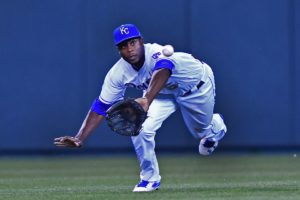 The “old school” baseball analyst will look at the Rangers rotation and be pleased, they are 4-0 with a collective ERA of 2.64. Yay. I’m not going to begin to explain that this is bad, but as sabermetric nerds will tell you, that doesn’t tell the whole picture. I’m not going to sit here and tell you I’m a sabermatrician, but I do appreciate these numbers more than the typical baseball stats. They may not all be easy to understand, but they paint a more full picture than Wins and ERA. One thing I like to look at is FIP, or Fielding Independent Pitching. This takes into account the factors that a pitcher can control, such as strikeouts, walks, batting average on balls in play, and ground ball percentage. A pitcher can’t control if they win or not. If they give up 1 run but the team is shutout did he pitch badly or deserve a loss? What if he gives up 8 runs and the teams scores 11, did he really contribute to the win? ERA is a basic stat, but what if you have 4 Michael Young’s on the infield and 3 Adam Dunn’s in the outfield? They may not make a ton of errors, but they don’t have much range so they’ll only get to a fraction of the balls better defenders make, so hits could be given up that would otherwise be outs with better defenders. Also, a pitcher with a relatively high batting average on balls in play (BABIP) is generally considered unlucky, on average it’ll be around .300. A high ground ball percentage generally implies there should be a lower batting average against and BABIP since statistically, few ground balls turn into base hits. With that in mind I’m going to look at our rotation through one turn and compare the up-front stats versus that sabermetric view.
The “old school” baseball analyst will look at the Rangers rotation and be pleased, they are 4-0 with a collective ERA of 2.64. Yay. I’m not going to begin to explain that this is bad, but as sabermetric nerds will tell you, that doesn’t tell the whole picture. I’m not going to sit here and tell you I’m a sabermatrician, but I do appreciate these numbers more than the typical baseball stats. They may not all be easy to understand, but they paint a more full picture than Wins and ERA. One thing I like to look at is FIP, or Fielding Independent Pitching. This takes into account the factors that a pitcher can control, such as strikeouts, walks, batting average on balls in play, and ground ball percentage. A pitcher can’t control if they win or not. If they give up 1 run but the team is shutout did he pitch badly or deserve a loss? What if he gives up 8 runs and the teams scores 11, did he really contribute to the win? ERA is a basic stat, but what if you have 4 Michael Young’s on the infield and 3 Adam Dunn’s in the outfield? They may not make a ton of errors, but they don’t have much range so they’ll only get to a fraction of the balls better defenders make, so hits could be given up that would otherwise be outs with better defenders. Also, a pitcher with a relatively high batting average on balls in play (BABIP) is generally considered unlucky, on average it’ll be around .300. A high ground ball percentage generally implies there should be a lower batting average against and BABIP since statistically, few ground balls turn into base hits. With that in mind I’m going to look at our rotation through one turn and compare the up-front stats versus that sabermetric view.
C.J. Wilson
5.2 innings pitched, 6 hits, 2 ER, 2 BBs, 6 Ks – 3.18 ERA
9.53 K/9, 3.18 BB/K, 0 HR/9 .353 BABIP, 41.2% ground ball rate – 1.89 FIP (Meaning his ERA should be 1.89 based on the factors he can control) 0.3 WAR (wins over replacement)
Sabermetrics say C.J. pitched very well and was unlucky based on his actual stats.
Colby Lewis
6 IP, 6 H, 3 ER, 2 BB, 4K – 4.50
6 K/9, 3 BB/9, 1.50 HR/9, .278 BABIP, 52.9 GB% – 4.78 FIP, 0.1 WAR
Colby was ok, and his results accurately reflect the projected outcome.
Derek Holland
6 IP, 7 H, 3 ER, 1 BB, 5 K – 4.50 ERA
7.5 K/9, 1.50 BB/9, 0 HR/9, .368 BABIP, 47.4 GB% – 1.78 FIP, 0.3 WAR
Holland pitched very well and was a little unlucky in how many hits fell in, as his ERA reflects.
Matt Harrison
7 IP, 5 H, 1 ER, 2 BB, 8 K – 1.29 ERA
10.29 K/9, 2.57 BB/9, 0 HR/9, .278 BABIP, 66.7 GB% – 1.52 FIP, 0.4 WAR
Harrison was outstanding and the results matched what should have happened.
Alexi Ogando
6 IP, 2 H, 0 ER, 2 BB, 4K – 0.00 ERA
6 K/9, 3 BB/9, 0 HR/9, .125 BABIP, 31.3 GB% – 2.62 FIP, 0.2 WAR
Alexi was great, especially considering he developed a blister in his last inning. His FIP indicates he was somewhat lucky which is about right because his BABIP was extremely low and his K rate wasn’t very high, but with power pitchers like Alexi you’ll see low ground ball outs as it seems batters tend to just get under the hard fastballs and hit pop ups, the same can be said of Feliz, who has had 4 perfect innings so far with most of his outs in play pop flies to the outfield.
Overall you can’t help but be impressed with the first turn through the rotation. Colby Lewis was the only one who pitched an average game and he was going up against a very impressive lineup, most of which who are lefties who rake against righties. I look forward to seeing how these guys pitch the rest of the year, especially if the incredibly small sample size of the first turn is any indication.



Great Article, I really enjoyed the breakdown and reading “the other side of the story”. Great job Mr. Lindsey.